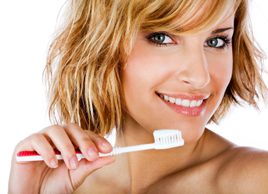5 things your toothbrush wants you to know
Think your teeth and gums are healthy? Double-check by asking your toothbrush for advice

You don’t have to be a veritable Toothbrush Whisperer to know when your teeth’s BFF is sending you a message. And when it does, you’d be wise to listen. The state of your toothbrush can provide useful feedback about your teeth, gums and overall dental health.
What’s your toothbrush trying to tell you? Read on for five common ‘messages.’ We asked Dr. Don Friedlander, president of the Canadian Dental Association (CDA) to interpret where necessary.
#1 If your toothbrush has blood on it’
It’s trying to tell you: You might have gingivitis!
‘The warning signs of gingivitis are puffy gums, traces of blood on your toothbrush, or a change in the colour of your gums,’ says Dr. Friedlander, noting the symptoms often come without pain.
Untreated gingivitis (gum inflammation) can worsen to periodontitis (which can lead to tooth loss). Recent studies have shown people with periodontal disease have an increased risk of cardiovascular disease.
The good news? Gingivitis is completely reversible.
What you should do:
‘ Brush your teeth twice daily;
‘ Floss daily;
‘ See your dentist for regular checkups and cleaning;
‘ Avoid excess sugar, and eat a balanced diet. ‘With the proper nutrients that come from healthy eating and proper oral hygiene, you can fight gingivitis,’ says Dr. Friedlander.
‘ If you smoke, quit. ‘Smoking’s a major contributor to gingivitis,’ says Dr. Friedlander.
#2 If your toothbrush is strangely coloured after you brush’
It’s trying to tell you: Maybe that Fun Dip wasn’t as harmless as you thought’
Candy residue can linger on your teeth in the form of sugar, acids and, obviously, the Technicolor dye on your toothbrush.
What you should do:
‘ For the sake of your teeth, cut back on candy. ‘Serve snacks that won’t harm teeth, such a vegetables, cheese, nuts or seeds,’ says Dr. Friedlander.
‘ When eating a sugary treat, save it for after a meal, when your mouth has plenty of saliva to help wash away the sugars and acids.
‘ Chase a dose of candy with a glass of water.
‘ Be vigilant about brushing and flossing ‘ if colourful residue’s on your brush, imagine what was on your teeth!
#3 If your toothbrush’s bristles are splayed out, worn-looking or missing’
It’s trying to tell you: Hel-lo?! Get rid of me!
The CDA recommends replacing your brush every three months ‘ but forgetting can be embarrassingly easy.
What you should do:
‘ Replace it, pronto.
‘ Also replace your brush immediately after you catch a cold or flu, to avoid re-infection.
‘ Try writing the first date of use on your brush with a permanent marker, to remind you just how old it is.
#4 If your toothbrush always gets worn out after just a couple weeks’
It’s trying to tell you: Brush up on your brushing skills!
‘This could be a sign that you’re brushing your teeth incorrectly,’ says Dr. Friedlander. While tooth brushing isn’t rocket science, there’s a right way and a wrong way to do it. Overzealous, aggressive brushing can damage teeth and gums.
What you should do:
‘ Check out the CDA’s simple step-by-step on Tooth Brushing 101. [ADD LINK TO: http://www.cda-adc.ca/en/oral_health/cfyt/dental_care/flossing_brushing.asp]
‘ If you’re still unsure, have your dentist or hygienist show you the right way to brush your teeth.
#5 If your toothbrush is stinky
It’s trying to tell you: Take better care of me ‘ and, by extension ‘ your mouth!
Toothbrushes can be breeding grounds for bacteria. Studies have found bristles harbouring harmful microbes like Streptococcus mutans (which can cause tooth decay) and Candida albicans (a fungus that can cause oral thrush)
Fears of bathroom bacteria have many people covering their toothbrushes. But plastic covers keep brushes damp longer, and germs multiply quickly. That includes potentially harmful microorganisms, as well as the kind that create a foul odour, not unlike a sour-smelling dishcloth.
What you should do:
‘ Get rid of your yucky brush now, and ditch the brush cover, too.
‘ Après brushing, rinse your toothbrush well, shake it off, and let it dry thoroughly in the open air. No need to use a high-tech UV toothbrush sanitizer.
‘ Prevent cross-contamination by not letting brushes touch or drip on one another.
‘ Don’t disinfect your brush in the microwave or dishwasher; both will harm the brush.
‘ Although pre-rinsing with an antibacterial mouth rinse or using it to give your brush a quick soak isn’t necessary for most people, the American Dental Association says people with compromised immune systems may benefit from this extra level of vigilance.




